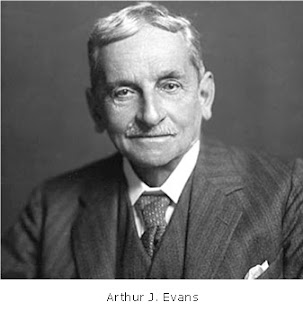Knossos, in Ancient Greek Κνωσός, is the largest Bronze Age archaeological site on Crete and has been called Europe's oldest city.
Settled as early as the Neolithic period, the name Knossos survives from ancient Greek references to the major city of Crete.
The name Knossos was formerly Latinized as Cnossus or Cnossos and occasionally Knossus, Gnossus, or Gnossos but is now almost always written Knossos.
The palace of Knossos eventually became the ceremonial and political centre of the Minoan civilization and culture.
The palace was abandoned at some unknown time at the end of the Late Bronze Age, c. 1380-1100 BC; the reason is unknown, but one of the many disasters that befell the palace is generally put forward.
In the First Palace Period, around 2000 BC, the urban area reached a size of as many as 18,000 people. In its peak, the palace and surrounding city boasted a population of 100,000 people shortly after 1700 BC.
The site of Knossos has had a very long history of human habitation beginning with the founding of the first Neolithic settlement (c. 7000 BCE). Neolithic remains are prolific in Crete. They are found in caves, rock shelters, houses, and settlements. Knossos has a thick Neolithic layer indicating the site was a sequence of settlements before the Palace Period. The earliest was placed on bedrock.
Arthur J. Evans, who unearthed the palace of Knossos in modern times, estimated that c. 8000 BCE a Neolithic people arrived at the hill, probably from overseas by boat, and placed the first of a succession of wattle and daub villages, modern radiocarbon dates have raised the estimate to c. 7000–6500 BCE.
Large numbers of clay and stone incised spools and whorls attest to local cloth-making. There are fine ground axe and mace heads of colored stone: greenstone, serpentine, diorite and jadeite, as well as obsidian knives and arrowheads along with the cores from which they were flaked. Most significant among the other small items were a large number of animal and human figurines, including nude sitting or standing females. Evans attributed them to the worship of the Neolithic mother goddess and figurines in general to religion.
More information: Archaeopress
Sir Arthur John Evans (8 July 1851-11 July 1941) was a British archaeologist and pioneer in the study of Aegean civilization in the Bronze Age.
He is most famous for unearthing the palace of Knossos on the Greek island of Crete. Based on the structures and artefacts found there and throughout the eastern Mediterranean, Evans found that he needed to distinguish the Minoan civilisation from Mycenaean Greece.
Evans was also the first to define Cretan scripts Linear A and Linear B, as well as an earlier pictographic writing.
Arthur Evans was born in Nash Mills, Hemel Hempstead, Hertfordshire, England, the first child of John Evans (1823-1908) and Harriet Ann Dickinson (born 1824), the daughter of John's employer, John Dickinson (1782–1869), the inventor and founder of Messrs John Dickinson, a paper mill.
John Evans came from a family of men who were both educated and intellectually active but undistinguished by either wealth or aristocratic connection. His father, Arthur Benoni Evans, Arthur's grandfather, had been headmaster of Dixie Grammar School at Market Bosworth, Leicestershire. John knew Latin and could quote the classical authors.
More information: Crete Classics
into habits of depersonalized learning,
alienation from nature and sexuality,
obedience to hierarchy, fear of authority,
self-objectification, and chilling competitiveness.
These character traits are the essence
of the twisted personality-type of modern industrialism.
They are precisely the character traits needed
to maintain a social system that is utterly out
of touch with nature, sexuality and real human needs.
Arthur Evans

No comments:
Post a Comment